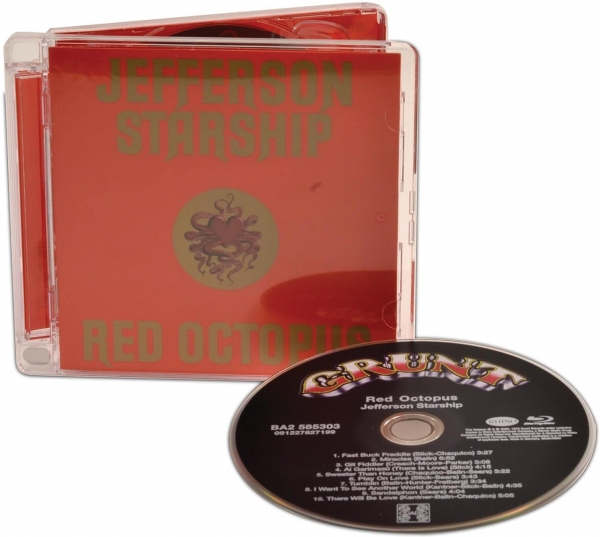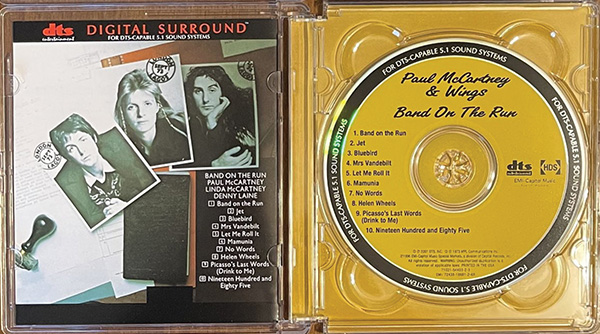| Columns Retired Columns & Blogs |
Just wanted to call out Tom Fine's great work here.

That story is mostly true, though the format thrived for a while in Japan and Germany, and it never fully died. Now, modern tech has made possible rereleases of 1970s quad albums on relatively common formats: multichannel SACD and Blu-ray discs (BD). No more "meh" LP formats, no more fussy 1970s-tech decoders. With a few hardcore adherents in the worlds of professional recording and music labels, the quad fire was never fully extinguished. Very early drafts of the "Red Book" Compact Disc standard included provisions for four audio channels; in fact, there were fringe efforts to revive quad on CD. A few companies released 2-channel discs with the audio matrix-encoded in either Dolby Surround (which could be run through a Dolby Pro Logic decoder common in home theater systems of the time) or DTS. Mobile Fidelity issued a few notable DTS-encoded CDs including Wings' Band on the Run and Venus & Mars (footnote 1).

In the early days of multichannel SACD, a few old quad mixes from the 1970s were dusted off and repurposed, but the industry's emphasis was always on 5.1 surround sound. Many albums once issued in quad were remixed from the multitrack session tapes to the more modern format, with a bias toward "round stereo" instead of sounds popping up from behind or flying over or behind the listener's head, gimmicks typical of those free and wild '70s quad mixes.
Finally, quad re-emerged from the shadows, ready for the post-CD world. In 2009, Rhino Records launched its Quadio series with two limited-edition DVD discs with DTS 4-channel audio: Chicago Transit Authority and The Best of Aretha Franklin. They sold out quickly. That success made Steve Woolard, Rhino's head of A&R, more ambitious. Next up was a box set, on BD with hi-def, non-lossy 4-channel audio, of Chicago's entire quad catalog, followed by a box of the Doobie Brothers' four quad albums. Then, last year, Rhino launched an ongoing series of single-BD Quadio releases.
Meanwhile, in England, Dutton Vocalion owner Michael Dutton licensed quad content from Sony, current owner of Columbia and RCA recordings, and has released a steady stream of dual-layer SACDs (the master stereo mix on the CD layer). Columbia, by far, offered the largest quad LP catalog back in the day, yet their SQ matrix-encoded format was least likely to throw convincing surround sound on a home system. The Dutton SACDs are the first time most of these albums can be heard in satisfying 4-channel surround (footnote 2).
In an interview, Rhino's Woolard said he's been a quad fan since the 1970s: "Ever since I first heard a quadraphonic demo, I was a fan. ... It's a different presentation that gives you a new perspective, uncovering bits that were either previously buried or not present in the stereo mix."
Dutton is also an OG quad fan: "I had the first EMI SQ quad decoder amp and speaker system. I had a lot of the old EMI/Capitol quads and some of the CBS ones. ... I've re-issued some of what I had back then."
Both said the quad market is niche but viable. Rhino plans four new titles each quarter this year; January releases were titles by Gil Evans, Randy Newman, Gordon Lightfoot, and War. Coming in May, albums by Seals & Crofts, Roberta Flack, Donny Hathaway, and Hot Tuna. Dutton's recent reissues include Henry Mancini albums originally on RCA plus Enoch Light Phase 4 titles and several Philadelphia International R&B hits.
In Japan, Sony has released some quad titles on SACD, in 7" LP-style sleeves with original cover art and insert materials including reproductions of old Sony quadraphonic equipment ads from the '70s and booklets containing original liner notes and historical essays.
To be a quad fan, you have to like the music of the early to mid-1970s. By about 1977, the major labels abandoned quad, although it lived on in Japan until the early 1980s.
My quad interests date from my older brother's circa-1974 Technics 4-channel receiver and his small pile of matrix-encoded LPs. Many years later, I was loaned a collection of 4-channel reel-to-reel tapes and finally understood the format's potential. Then SACD and DVD surround sound came along. Several years ago, I acquired a near-mint top-line Sansui quad receiver from 1976, with onboard decoding of all the LP formats (SQ and Sansui's own QS matrix formats plus JVC's CD-4 discrete-channel system). Soon afterward, I was given a large collection of quad vinyl.
Although it's fun to play with the vintage platters and hear the quad sounds of the 1970s, the problems with the formats are obvious. SQ and QS matrix-encoded records, especially as played through original decoders, have inadequate channel separation and tend to fold down to "big mono" when the music is complex and loud. This is especially true with symphonic music. CD-4 discrete-channel records require a special cartridge—the Shibata stylus was invented for this—and the grooves can get worn down, so the high-frequency FM carrier drops out and the rear speakers go silent (although in my experience, playing a medium-sized pile of CD-4 records with a vintage Audio-Technica cartridge made for that format (below), the records can be pretty beat up and still produce consistent quad sound). If you own a pile of old matrix-encoded (SQ and QS) quad records and don't want to mess with 50-year-old hi-fi gear, consider the Surround Master V3 from Involve Audio (footnote 3).

But if you're in it strictly for the music, there's no contest: The new, shiny disc reissues far outshine the old LPs. Assuming the four-track master tape is still available and in good shape, these new reissues will sound as the artists intended.
A listening tip: If you don't use four fullrange/full-sized speakers and your system allows you to direct the bottom two octaves to a subwoofer, do it. In contrast to the quad LP formats, the low bass shines with well-recorded discrete-channel quad HD.
Footnote 2: Here is a listing of Dutton's SACD offerings, many reissues of quad albums: tinyurl.com/DuttonSACD; note the sorting options to the right.
Footnote 3 See tinyurl.com/4594uzwh.

Just wanted to call out Tom Fine's great work here.

Yes, they are the best recordings. I have a quad of Joan Baez, and one of the Big Bands. They are amazingly clear, sweet, and natural. The imaging is amazing even in ordinary two channel.

Also interesting back in the early 70s was the many ways quadraphonic material was broadcast.
Early on, the typical way was to use 2 radio stations, usually two FM stations. For instance in NYC, there were broadcasts on WNYC-FM and WKCR, with the front channels on WNYC and the rear channels on WKCR. Among the quad programs was a series called Experiments In Sound hosted by Harry Maynard. In Boston, the BSO broadcast in Quad throughout the 1970s. This arrangement was interesting because one FM station broadcast the left front and rear and the other broadcast the right front and rear. WCRB and WBGH, both FM.
Later, when home listening equipment included matrix-decoding, stations around the country broadcast SQ or QS encoded content. For example, a station could do something as simple as program a "Quad Hour" and play SQ-encoded records, with the listeners decoding at home (the matrix-encoding probably got somewhat mangled by FM broadcast and reception). Or, a station might produce original content and matrix-encode it on the way to the tower or record it to tape using a SQ or QS encoder.
Many different things were done, and there were many quad broadcasts around the country when the fad was hot.

There is a forum dedicated to discussions of surround sound recordings, from the original vinyl matrix recordings up to the latest from DV and Rhino. We’re a pretty fun bunch, don’t bother with politics or religion (other than good sound) and it’s remarkably active.
quadraphonicquad.com
Join us!